In the Scottish Highlands, Danny Adcock walks the rows and peaks of geological time.
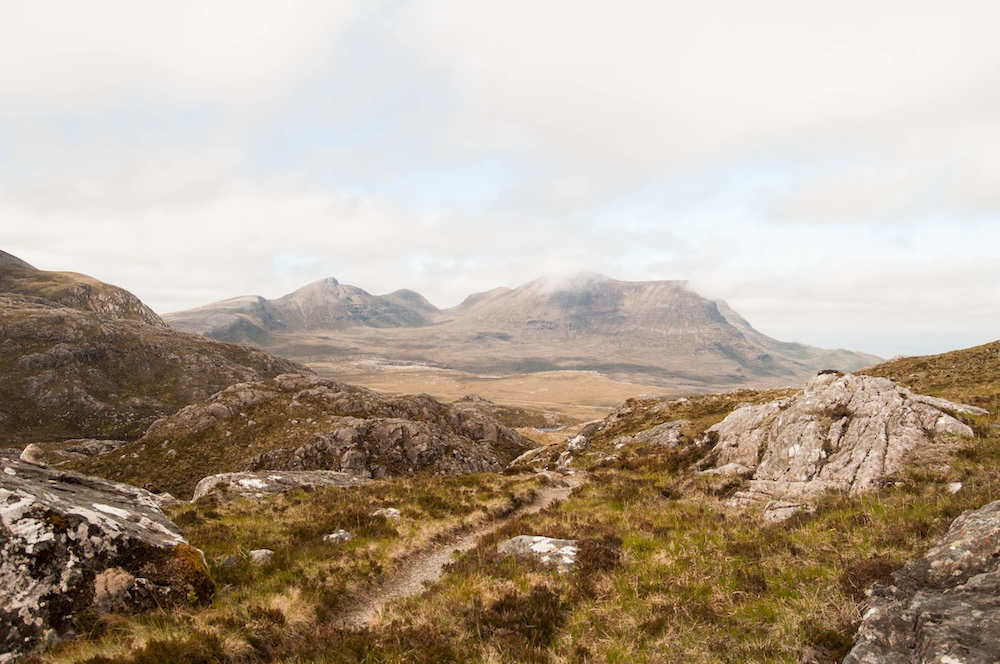
Twelve hours up the road from sleepy Norfolk lanes that, verged with umbellifers and ox eyes, meander gently across the backs of rolling chalk breakers on their way to the coast, I found a landscape of antithesis: of vertiginous drops from blue-grey rock scored by time and yellow-orange lichen, of peat bog, and monolithic mountains rising whale-backed and ageless.
It took me fifty years to get to Scotland, and until I read At the Loch of the Green Corrie by Andrew Greig, which incidentally I discovered after Tom Fort reviewed it here on CBTR in 2010, I had never heard of Assynt. Back then I was only just discovering fly-fishing, but Greig’s cathartic book had remained, biding its time silently on my bookshelf for more than a decade until one day catching my eye and earning a re-read. By this time fly-fishing had become something of a compulsion, though I’d pretty much internalised Scotland until somehow the book metamorphosed the vague sense that someday I must see it, into I’m-fifty-fucking-years-old-if-I-don’t-do-it-now-when-will-I? So I stuck a metaphorical pin into an online cottage and here we were.
Eagle Cottage was perfect for me and the dog: kitchen-diner, small lounge and reasonably comfy bed. But I could see the impossibly steep and narrow staircase watching me out of the corner of its eye, probably imagining the fun it was going to have when I needed to use the downstairs loo in the middle of the night. The deep-set windows must have been offering the same views of Culkein bay and Assynt’s mountains for generations. Behind it a sweep of hill hid the nearest loch and the local delinquents – ravens and hooded crows that tumbled down the wind, and settled on the bones of an old croft, long-since abandoned and fallen into the heather.
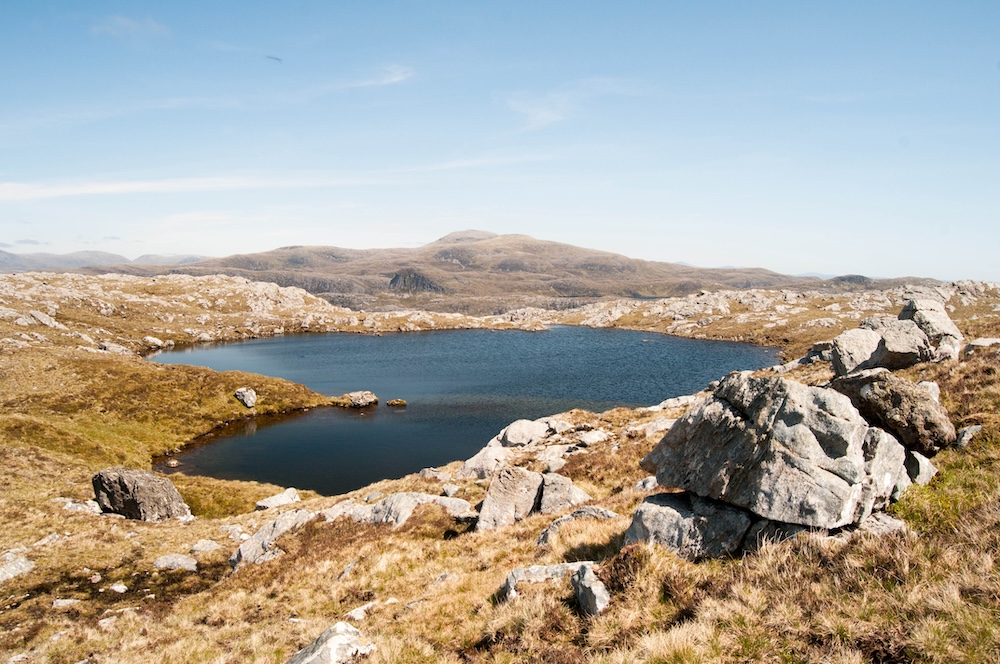
I’ve been a part-time writer for a couple of decades now. My first published article was on this website, and in print-proper Waterlog magazine. If I’ve learnt anything since those first naïve scratchings it’s that hyperbole and cliché are the enemy of meaning. Don’t get tied up with convoluted metaphor or simile that obscure your subject and run to paragraph-length sentences. Keep it short, and use metaphors that are relevant. I once wrote about an episode from my childhood when my mum worked in the pub round the corner. Dad used to send me up there with her to buy his fags and then I’d run home with them. I compared the inside of the cigarette machine with the inside of a nicotine-stained lung. When the editor pointed out that the internal workings of cigarette machines are nothing like lungs, I could hardly disagree. However, when it comes to hyperbole, Assynt’s landscape defies it utterly and, actually, it’s almost impossible to describe the place without running to hyperbole.
Like much of the Highlands, this corner in the far north-west is sparsely populated – another thing in its favour in my opinion. Even though, in summer, campsites are busy and getting stuck behind a campervan is to be expected, it’s a very simple matter to get out on the hill and leave the hordes behind. When I first researched the area my motivation was the fishing. Worryingly, I found more than one apocalyptic description online of throngs of anglers at the Loch of the Green Corrie, but, on two trips up there I didn’t see another soul. And what a stunning setting for a trout loch.
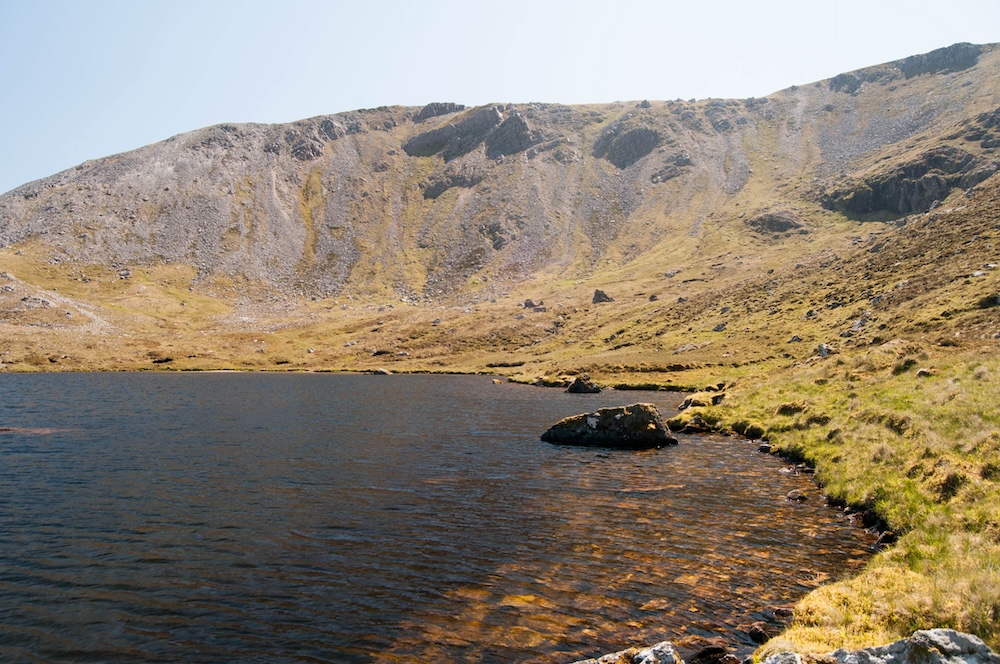
I parked the car in a lay-by where the A894 switchbacks down towards Kylesku bridge, and followed the path that skirts the northern shore of Loch na Gainmhich, where the sleek-grey of my first red-throated diver bobbed. Up the boggy sides of Coir’ a’ Bhaic we went, black lab Eddie and I. Then up and along Cnoc na Criege’s bonier shoulders. The view back down the pass would have taken my breath away if the gradient hadn’t already. The road was a pale, lost strand of thread just visible on the far side of the loch, and beyond that the majesty of Quinag, one of Assynt’s distinctive mountains, obscured the sea. At just over 800 metres, its trio of peaks – Spidean Coinich, Sàil Ghorm and blunt-nosed Sàil Gharbh – shouldered the morning’s cloud aside like the front row of a rugby scrum; this is nature’s own Brutalist architecture, but with a heart-wrenching quality concrete can never match. One of Assynt’s quirks is that its mountains are not aligned into a ‘range.’ Rather they seem disassociated, independent, random even. Quinag, Stac Pollaidh, Ben More, Conival and Suilven make up an archipelago amongst an ocean of hills and peaks. To see Suilven rise in isolation like a monument to time is worth seeing again and again.
For directions to the best trout fishing I was using an excellent little book by local angler Cathel MacLeod, in which he details thirty lochs, and how to find them. It’s worth mentioning there are far more than thirty lochs in the area and to write about them all might be the work of several lifetimes. MacLeod describes the walk to Lochan a’ Choire Ghuirm – to give the Loch of the Green Corrie its Gaelic name – as ‘moderate’ but, when you’ve lived in Norfolk for the last twenty-five years as I have, consider that description subjective.
This landscape, despite its scale, can be intimate and enigmatic. Yesterday I followed MacLeod’s directions up to Lochan Bealach Cornaidh, below Quinag’s eastern slopes, and there I caught my first Scottish, wild brown trout. He also suggests fishing the smaller, often unnamed lochs, one of which is found north of the stalker’s path I had followed earlier. From a hundred metres above it was easy to spot, tucked under an oblique ridge named Druim na h-Uamha Mòire, and I picked out a rock I thought would lead me to it. But rocks are ubiquitous here, jutting angularly from the ground in great, ice-smoothed sheets, or randomly strewn across the slopes in various sizes, and once up close it was a different matter. Eventually we found it though, where a small, boggy valley opened out below the ridge.
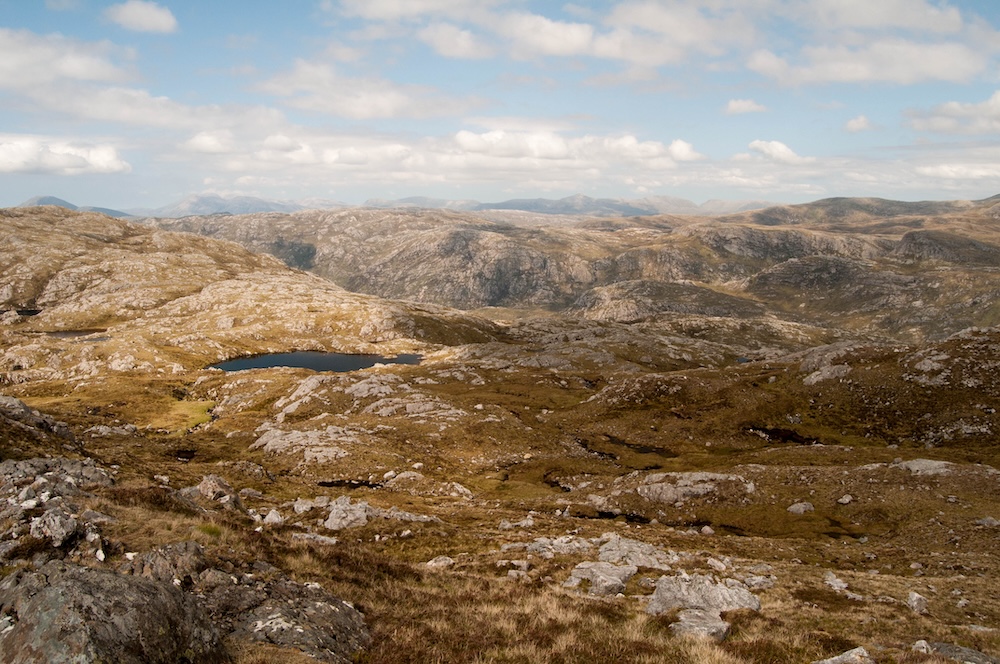
Cathel MacLeod’s directions to the Loch of the Green Corrie are straightforward. Follow the path up from Loch na’ Ghainmhich until you pass Lochan Bealach a’ Bhuirich. Then, at the path’s highest point, leave it and head due south. Not having walked in the Highlands before, abandoning the path was a leap of faith. But I’d come this far and I wasn’t about to turn back now, so I took a compass bearing and headed down across the heather and grass. Initially we were aiming for another anonymous loch on the OS map, which is colloquially known, in a nod to its bigger, higher cousin as ‘Little Green.’ An unproductive hour’s fishing later and we were heading up again. Between the two lochs the contours narrow into a lung-busting seventy metres following a little burn that laughs in places and whispers in others. There’s falling water everywhere in Assynt including the highest waterfall in the UK, Eas á Chual Aluin, which plunges into a lonely, hidden valley not far from here.
The Loch of the Green Corrie sits at over 500 metres, its stoic water dark in the possessive arms of its corrie, and its trout stubbornly elusive. A lone ringed plover – its colours perfectly matched to the heather – protests our appearance, though soon gets bored and leaves us to the silence. It is truly awe-inspiring; on the western and southern sides is the towering corrie, its slopes brushed eponymously green and mostly benign at the loch-side, steepening to treacherous-looking screes of grey near its curling top lip. In places boulder-faced outcroppings with deep, frowning eyebrows of shadow stare down. Corries begin as mere hollows on north-facing mountainsides that harbour enough frozen snow to form glaciers. Over millennia the downward progress of the ice plucks rocks from the mountain and drags them along, scouring out a corrie. To look out north and west with the corrie-slopes behind, is to see rows and peaks of geological time before you: the Stack of Glencoul, Sàil na Slataich, Beinn Leòid, Meallan a’ Chuail, and on.
Writing about landscape and place sometimes becomes over-reliant on finding inherent meaning when, in fact, we bring meaning with us. Essentially it’s about significance and understanding, not only of the landscapes we inhabit either permanently or fleetingly, but of ourselves and others. People are the conduit of meaning because, as Richard Mabey wrote, landscape is about narrative; of mountain, of eagle, of trout, of deer and of people. A.A. Gill – a rather different writer to Richard Mabey – wrote about Scotland’s landscape as holding a kind of melancholy. I didn’t agree with much of Gill’s snobbish and elitist, though admittedly sometimes amusing, views of the countryside (he described my home county as a ‘hernia on the end of England’ and the food at my local as ‘Shrek fart’) but this I can sense myself. Sutherland suffered appallingly in the Highland clearances with 15,000 people forced from their homes to make way for sheep. Even without enduring the clearances crofting was, and is, a tough and financially unrewarding lifestyle. In Assynt though, crofters have gone some way to overturning the memories of those horrific injustices.
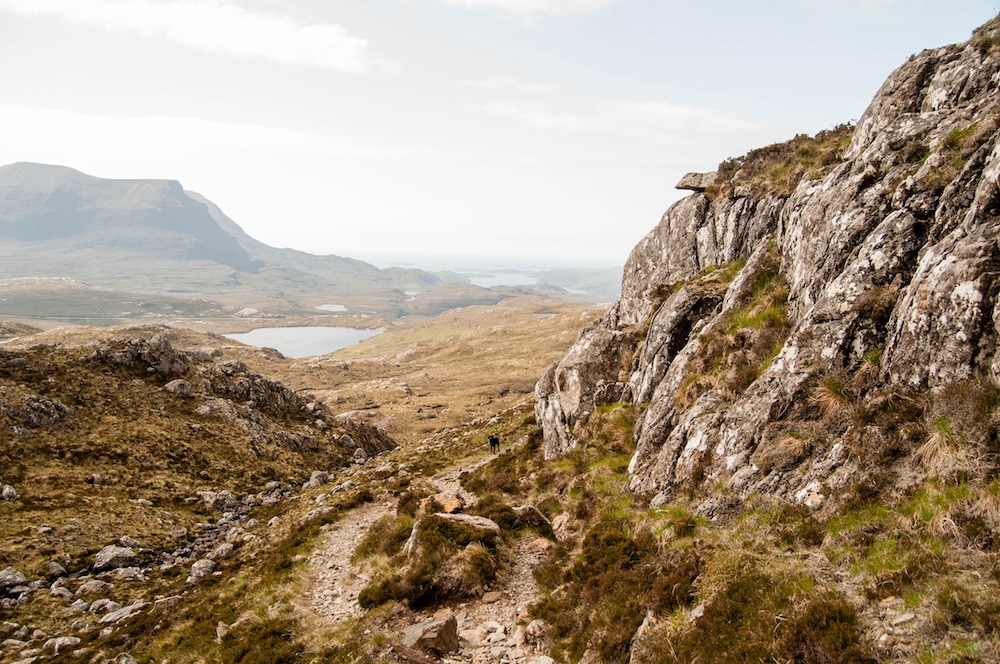
In 1992, following the liquidation of the Scandinavian property consortium that owned the land, the Assynt Crofter’s Trust managed to acquire it for themselves. I don’t think it has made them rich and, from what I’ve observed, crofting is still a hard way of life in what, though beautiful, must be an inhospitable place at times. But to know those working the land own it, live it and care about it is to give it a very deep meaning indeed. Supposedly the feudal system ended centuries ago yet, in general, land-ownership models remain heavily weighted in favour of the few. For the Assynt Crofters’ Trust to have kicked against this extant, quasi-feudalism as Guy Shrubsole calls it, I find somewhat heartening with my, slightly forlorn, working-class sensibilities. I also take pleasure from the fact those A.A. Gill called ‘wall-eyed, tongue-tied, spittle-flecked,’ are more than capable of overturning centuries-old stereotypes given the chance.
It’s a cliché to consider wilderness ‘life-affirming’ and the truth, like most things, is probably more complicated. But mountains can change you. I can’t tell you how, or why – that you’ll have to find out for yourselves – I only know they can. On our final morning in Assynt, Eddie and I went up behind the cottage to see if we could spot a last trout-rise on Loch Cùl Fraoich, and look at the whisps of bog cotton that flicker across the slopes. High over Sìthean Mòr I watched a pair of sea eagles on the ragged wind above the hill. After a while, they turned toward the sea and flew off; Eagle Cottage had lived up to its name.